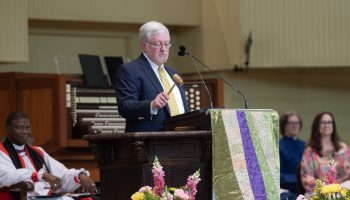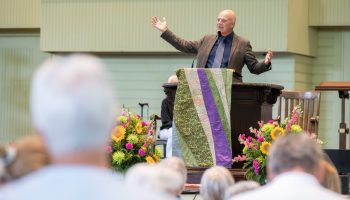
The Rev. Richard Kannwischer delivers his sermon “What I Got Wrong About Faith” during the morning worship service Sunday in the Amphitheater.
The Rev. Richard Kannwischer, eighth senior pastor of Peachtree Presbyterian Church in Atlanta, preached at the 10:45 a.m. Sunday morning worship service in the Amphitheater. His theme for his preaching series is “Because I Believe.” The title for the Sunday sermon was “What I Got Wrong About Faith,” and the scripture text was Matthew 8:5-10. His sermon topic was “Because I Believe in God, I will Trust Him.”
When he was a pastor in San Antonio, Kannwischer and his wife hired a seminary student to be a nanny for their two children for the summer. The whole family, including the nanny, went to Sea World one afternoon to see a new show.
There were trained whales and dolphins, and over the loudspeaker there was music. A whale would jump; the song “Believe” would play; and the crowd would cheer. The dolphins would jump and the same music would play and the audience would cheer.
Kannwischer looked at the seminary student, who was sitting quietly and not applauding. She said, “Believe? Believe in what — a whale?”
There does have to be something we put our faith in, Kannwischer said — an object we are confident about.
Kannwischer was the pastor of a church in Summit, New Jersey, on Sept. 11, 2001.
“It was not a media event for us,” he said. “It was personal. The number of people from Summit who were killed on 9/11 was the same number as in World War I and again in World War II.” There were 14 people in his congregation who worked in the Twin Towers at the World Trade Center.
For weeks he went from home to home, checking in on church families. At one house, Kannwischer arrived and stood in the door frame, backlit by the sun. Being about the same height and build as one of his departed parishioners, Debbie, the woman of the house, thought for a moment that her husband had come home.
One day, the Rev. Thomas Long, then president of Princeton Seminary, called Kannwischer and invited him to lunch and to let Long “be a pastor to him.”
Kannwischer told Long that he did not know what to believe anymore. Long told him that was understandable, because “the great myth of faith in America is it doesn’t matter what you believe, as long as you believe it sincerely.”
Faith is the substance of things hoped for, the evidence of things not seen, Kannwischer said, quoting Hebrews 11:1: “What we believe most is the most substantive thing about us.”
He continued, “The first thing I got wrong is that ‘I’m OK, you’re OK’ theology’ is enough. It is significant what we say we believe in at our core.”
The second thing Kannwischer got wrong about faith was “not understanding what faith means.” As a Presbyterian, who are “the church’s theological nerds,” he thought faith was about intellectual assent to the right kinds of beliefs.
“Faith is about trust; it is relational,” he said. “Jesus taught with authority.”
Kannwischer reminded the congregation that Palestine, in Jesus’ time, was occupied territory and centurions were among the most hated occupiers. It was a shock when a centurion approached Jesus, a Jewish rabbi, and told Jesus he only had to say the word and his servant would be healed.
“Imagine the shock (to Jesus’ listeners) when Jesus said he had never seen faith like that,” Kannwischer said. “For the longest time, I thought I had to get the doctrine right, because you have to put your confidence in something. You don’t know faith until you try to teach your child to drive in a major American city.”
To show the difference between a profession of faith and the practice of faith, Kannwischer told the story of Jean François Gravelet, also known as Monsieur Charles Blondin.
Blondin was one of the first men to walk across the cataract of Niagara Falls on a 2-inch wide rope that stretched 1,300 feet.
He crossed with a pole, a table and chair; one time he cooked an omelet that he then lowered to passengers on the Maid of the Mist tour boat below.
He walked forward, backward, on his hands, blindfolded. One time he asked for someone to go over on his back. His manager, Harry Colcord, volunteered.
“I think he volunteered because he had watched Blondin over and over and believed that he could do what he said he would do,” Kannwischer said.
Blondin told Colcord, “ ‘Look up, Harry … you are no longer Colcord, you are Blondin. Until I clear this place, be a part of me, mind, body and soul. If I sway, sway with me. Do not attempt to do any balancing yourself. If you do, we will both go to our death.’ ”
Kannwischer cited Roman Catholic theologian Michael Novak, who has said that there are three levels of beliefs.
“Public belief is what we say we believe, private belief is what we think we believe, and core belief is what we actually believe — even if we are not aware of it,” Kannwischer said. “Novak posits that we never violate our core beliefs.”
Kannwischer continued, “If we took an MRI of your soul, what would we read? What do you put your faith in — money, leisure, success, health? Some people put their faith in faith, which is like a dog chasing its tail.”
When George H. W. Bush was 89, the child of one of his Secret Service agents, a 2-year old named Patrick, was diagnosed with leukemia. The security detail, to show support for Patrick, shaved their heads. Bush also shaved his head, not as an academic exercise or just to show solidarity but because he had a 3-year old daughter, Robin, who died of leukemia in 1953.
Kannwischer asked, “Did the detail trust the president? Yes, because of his faith, support and love for them.”
As an example of the faith that is in a person’s core, Kannwischer used the Apostle’s Creed. He had brought with him a handout with “Because I Believe” on one side using the Apostle’s Creed as a litany of belief. On the other side were details of his preaching series for the week.
There was an old man in a congregation who used to lead the Apostle’s Creed. Each Sunday he would invite the congregation “to stand and say what we believe and in whom we believe.”
“God, this is what I got wrong about faith for a long time,” Kannwischer said and invited the congregation to use the handout and read the litany. “This is the ‘so what’ of the Apostle’s Creed; it is what is in our core.”
The Rt. Rev. Eugene Taylor Sutton, senior pastor of Chautauqua Institution, presided. Melissa Spas, vice president for religion at Chautauqua Institution, read the scripture. The prelude was “Prelude,” on Slane by Healey Willan, performed by Joshua Stafford, director of sacred music and the Jared Jacobsen Chair for the Organist, on the Massey Memorial Organ. For the anthem, the Chautauqua Choir sang “Love bade me welcome,” music by David Hurd and text from George Herbert’s “The Temple.” The Choir sang a cappella under the direction of Stafford. The offertory anthem, sung by the Chautauqua Choir, was “The Secret of Christ,” music by Richard Shephard and text from Isaiah 42: 14-16; Revelation 22: 1-3, and Colossians 4: 2-4. The choir sang under the direction of and was accompanied by Stafford. The postlude was “Fanfare,” by John Cook, played on the Massey Organ by Stafford. Support for this week’s services and chaplaincy is provided by The Robert D. Campbell Memorial Chaplaincy and the Mr. and Mrs. William Uhler Follansbee Memorial Chaplaincy.




